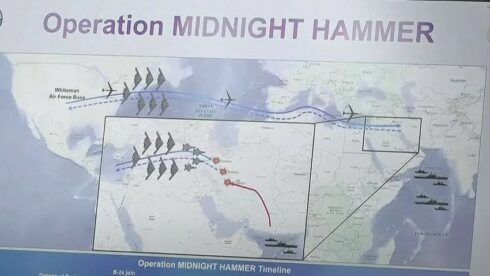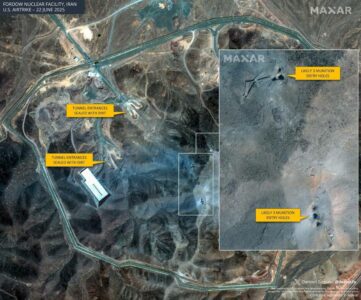Seven B-2 Spirit stealth strategic bombers were used in the United States attack against Iranian nuclear sites on the morning of June 22, top general Dan Caine said at a Pentagon news conference, revealing that the complex operation was codenamed “Midnight Hammer”.
The Joint Chiefs Chairman said that “main strike package comprised of seven B-2 Spirit bombers” flying 18 hours from the U.S. mainland to Iran with multiple aerial refuelings.
“Iran’s fighters did not fly, and it appears that Iran’s surface to air missile systems did not see us throughout the mission. We retained the element of surprise,” Caine added.
According to the general, a total of 14 GBU-57 Massive Ordnance Penetrator (MOP) bombs, more than two dozen BGM-109 Tomahawk land-attack cruise missiles and over 125 military aircraft were employed during the operation.
He also revealed that the deployment of U.S. bombers over the Pacific a day earlier was a “decoy,” part of a wider deception effort known to only a limited number of the operation’s planners.
The goal of the operation – destroying nuclear sites in Fordow, Natanz and Isfahan – has been achieved, according to Caine.
“Final battle damage will take some time, but initial battle damage assessments indicate that all three sites sustained extremely severe damage and destruction,” the general said.
A Pentagon-provided map of the flight path taken by the bombers indicates that their approach to Iran took them over the Mediterranean and then over Israel, Jordan, Syria and Iraq.
Speaking during the same conference, Defense Secretary Pete Hegseth said that the attack was an incredible and overwhelming success that have “obliterated” Tehran’s nuclear ambitions.
“We devastated the Iranian nuclear program,” Hegseth said, adding that the operation “did not target Iranian troops or the Iranian people.”
Satellite images released by Maxar show at least six holes on the mountainside at Fordow site, where the 14-ton MOP bombs impacted. The bunker buster bomb is believed to be able to penetrate about 61 meters below the surface before exploding.
While Atomic Energy Organization of Iran has not yet offered any details of the damage at Fordow, it did state that the Islamic Republic’s knowledge in the nuclear field “cannot be destroyed.”
“They should know that this industry has roots in our country and the roots of this national industry cannot be destroyed,” agency spokesman Behrouz Kamalvandi said, according to Tasnim news agency. “Of course, we have suffered damage, but this is not the first time that the industry has suffered damage.”
Meanwhile, the Iranian government there is no immediate danger to the public after the U.S. attack on the three nuclear sites.
“There is no danger to the people living on the outskirts of our nuclear areas,” spokeswoman Fatemeh Mohajerani said on state television. “The people of Natanz, Isfahan and Fordo can continue their lives.”
Iran has already vowed to retaliate. Responding to this, U.S. Secretary of State Marco Rubio warned that such an action would be “the worst mistake they’ve ever made.” At the same time, Rubio said that that the offer for diplomacy with the Islamic Republic is still open, and that regime change is “not the goal” of Washington.
_______________________________________________________________________________________________________________________
SouthFront: Analysis and Intelligence
NOW hosted at southfront.press
Previously, SouthFront: Analysis and Intelligence was at southfront.org.
The .org domain name had been blocked by the US (NATO) (https://southfront.press/southfront-org-blocked-by-u-s-controlled-global-internet-supervisor/) globally, outlawed and without any explanation
Back before that, from 2013 to 2015, SouthFront: Analysis and Intelligence was at southfront.com







